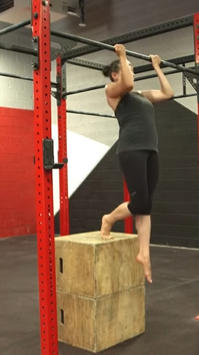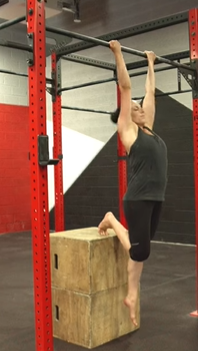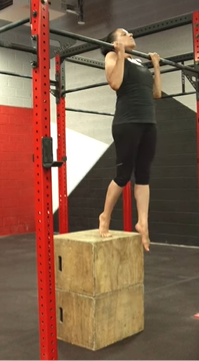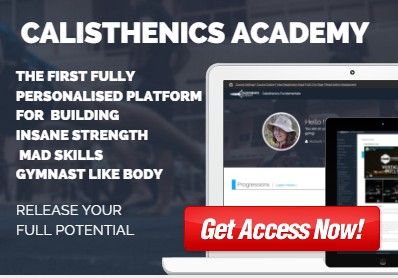Have you ever found yourself staring at the pull-up bar, determined to conquer the elusive chin-up, but it feels like an uphill battle? 🥺
What if I told you there’s a game-changing technique that transforms your chin-ups into a full-body symphony and serves as the ultimate stepping stone for beginners and form perfectionists?
Enter the world of one leg-assisted chin-ups – where innovation meets strength-building!
You engage your upper body muscles💪 by using one leg for assistance while gradually reducing the support needed.
Ready to unravel the secrets and take your chin-up game to the next level? Let’s dive in!
🙌 What is Chin-Up?
A chin-up is a resistance training exercise designed to engage the upper body muscles, primarily focusing on the back, biceps, and shoulders. It involves lifting your body upwards by gripping a horizontal bar with your palms facing you.
The goal is to pull your body up until your chin passes the level of the bar. They can be challenging, making them popular for those looking to enhance their upper body strength and functional fitness.
To know more about chin-ups, read our article on 📍 How to Do Chin-ups: Chin-up Mastery Unveiling Muscles Worked and Performance Benefits.
🔥One Leg-Assisted Chin-Ups
One leg-assisted chin-ups are a variation of the traditional chin-up exercise that incorporates using one leg for support and assistance. In a standard chin-up, the focus is on engaging the upper body’s muscles, such as the biceps, lats, and traps. However, with one leg-assisted chin-up, the lower body actively participates in the movement.
Here’s how it typically works: as you grip the pull-up bar, securely position the assisting leg’s foot on top of the box and begin to pull your body upwards. Simultaneously, extend the non-assisting leg straight in front, maintaining a parallel position to the ground.
The engaged leg serves as a supportive anchor, helping to distribute the workload more evenly and making the exercise more accessible, especially for beginners or those working on refining their form.
One leg-assisted chin-ups offer a strategic progression strategy. By gradually reducing the support from the leg over time, you can work towards achieving unassisted chin-ups while still reaping the benefits of a challenging upper-body workout.
This variation incorporates dynamic movements, providing a holistic approach to strengthening muscles and enhancing overall fitness.
🏆Benefits of One Leg-Assisted Chin-up
This modification to chin-ups not only makes the exercise more accessible for beginners but also provides unique benefits to your overall fitness and strength development. Here are some of the reasons why you should try the one leg-assisted chin-up:
1️. Progressive Strength Building
With each workout, you can gradually decrease the support from your leg. This challenges your muscles and ensures a steady progression, fostering increased strength and adaptability.
2️. Muscle Activation
One leg-assisted chin-up targets the same 📍 muscle groups as full pull-ups, honing in on your back and biceps. This focused engagement promotes the development of essential strength and control.
3️. Boosted Confidence
Conquer each step in the progression and watch your confidence soar. Every achievement brings you closer to your ultimate 📍 pull-up goal, creating a sense of accomplishment and self-assurance!
4️. Improved Form and Control
The strategic use of one leg in the assisted chin-up distributes the workload and encourages controlled and intentional movement. This helps refine your form, preventing swinging or momentum-driven actions and ensuring a more precise and effective workout.
5️. Reduced Strain on Joints
One leg-assisted chin-up provides a gentler entry into the world of pull-ups, reducing the strain on your joints compared to traditional pull-ups. This makes it an excellent choice for individuals looking to strengthen their upper body without overwhelming joint stress.
6️. Versatile Adaptation for All Fitness Levels
Whether you’re a beginner aiming to conquer your first pull-up or an experienced fitness enthusiast refining your skills, one-leg assistance offers a versatile approach. Tailor the level of support to your current fitness level, ensuring inclusivity and effectiveness for all.
7️. Engages Core Muscles
The dynamic nature of one leg-assisted chin-up requires engagement from your core muscles to maintain stability. This added benefit not only contributes to overall core strength but also enhances the efficiency of the exercise.
Incorporating one leg-assisted chin-ups into your workout routine goes beyond building strength; it’s a holistic approach to refining your technique, boosting confidence, and making pull-ups an achievable milestone in your fitness journey.
😱How to Do a One Leg-Assisted Chin-Up?
If the full chin-up is challenging, you can also perform a modified version using a sturdy box or platform. Here’s how you can adapt the chin-up exercise with a box:
1. ✔️Set Up a Box
Place a sturdy box or bench beneath the pull-up bar. Ensure that it is stable and won’t slip during the exercise. Opt for a box height that allows you to maintain proper form throughout the exercise. The ideal height is one that positions your chin just above the bar when standing on the box. This ensures a challenging yet controlled movement.
2. ✔️Grip the Bar
Reach up and grip the pull-up bar with both hands, using a supine grip (palms facing towards you), and position yourself above the box.
3. ✔️Placement of the Assisting Foot
Choose which leg will assist. Place the foot of the assisting leg on top of the box. This foot will be responsible for pushing against the box to aid in the upward phase of the chin-up.
4. ✔️Extend the Other Leg
Extend the non-assisting leg straight in front of you, parallel to the ground. Keep this leg straight throughout the entire movement, engaging the muscles in your core for stability.
5. ✔️Engage Core Muscles
Engage your core muscles to maintain a straight and aligned body position. This engagement ensures stability and control during the exercise.
6. ✔️Chin Over the Bar
Continue pulling yourself up until your chin is over the bar, maintaining control and engaging the targeted muscles.
7. ✔️Lower with Control
Slowly lower your body back down to the box, keeping the assisted leg bent and controlling the descent. Focus on muscle engagement throughout the entire range of motion.
8. ✔️Repeat the Movement
Complete the designated repetitions, ensuring the non-assisting leg maintains a straight position throughout the set. Focus on consistency to optimize the benefits of the exercise.
9. ✔️Focus on Breathing
Coordinate your breathing with the movement. Inhale as you lower your body, and exhale as you pull yourself up. Consistent breathing contributes to endurance and overall performance.
10. ✔️Gradual Progression
Over time, as your strength improves, consider reducing the assistance from the box. Gradually decreasing the reliance on the box challenges your muscles more intensely, promoting continuous progression.
Using a box for one-leg-assisted chin-ups provides additional stability and support, making the exercise accessible to individuals who may find the hanging variation too tricky. As with any exercise, prioritize proper form and gradually progress as your strength improves.
Here’s a YouTube video short on how this exercise is done:
💪Muscles Engaged During a One Leg-Assisted Chin-Up
A one-leg assisted chin-up engages several key muscle groups throughout the upper body. The exercise primarily targets the muscles involved in the traditional chin-up while placing additional emphasis on specific areas due to the assistance provided by using only one leg. Here are the primary muscles engaged during a one-leg assisted chin-up:
- 👊 Latissimus Dorsi
The lats are the primary muscles targeted during chin-ups. They are responsible for the pulling motion and contribute significantly to the width and V-shape appearance of the upper back.
- 👊 Biceps Brachii
The biceps play a crucial role in the flexion of the elbow joint during the pulling phase of the one-leg assisted chin-up. They are located on the front of the upper arm and are heavily engaged in the movement.
- 👊 Trapezius
The traps are divided into upper, middle, and lower portions. They assist in both the retraction and depression of the shoulder blades, providing stability and control during the one-leg assisted chin-up.
- 👊 Pectoralis Major
The chest muscles are involved in the pulling motion, particularly during the lower part of the exercise. While not the primary focus, the pectoralis major contributes to the overall engagement of the upper body.
- 👊 Brachialis
Situated underneath the biceps, the brachialis is involved in elbow flexion and is activated during the pulling phase of the one-leg-assisted chin-up.
- 👊 Forearm Muscles
The muscles in the forearms, including the brachioradialis and flexor carpi radialis, are engaged to a certain extent in maintaining grip strength and control throughout the exercise.
- 👊 Abdominals
The core muscles, including the rectus abdominis and obliques, play a role in stabilizing the torso during the movement. Keeping the core engaged helps maintain proper form and prevents excessive swinging.
- 👊 Quadriceps and Hip Flexors
The extended leg assists by engaging the quadriceps and hip flexors to a certain degree. These muscles stabilize the body and assist in the controlled lifting phase.
Understanding the muscles engaged during a one-leg-assisted chin-up can help you tailor your workout routines to target specific upper body areas. Additionally, focusing on proper form and controlled movements will maximize the effectiveness of the exercise and reduce the risk of injury.
✨Tips for Success When Doing a One Leg-Assisted Chin-Up
This challenging exercise targets various upper body muscles and demands a strategic approach for continuous improvement. Whether you’re a beginner or looking to refine your technique, these tips will guide you toward success in performing one-leg assisted chin-ups.
- ⚡️ Establish a Stable Grip
Ensure a secure grip on the chin-up bar, and place your hands slightly wider than shoulder-width apart. A solid grip is crucial for control and stability during the movement.
If you want to improve your grip strength, our article 📍 Exercises That Will Help You Improve Your Grip Strength can help.
- ⚡️ Correct Body Position
Maintain a straight and aligned body from head to toe. Refrain from doing excessive swinging or arching of the back, as it may undermine the effectiveness of the exercise and heighten the risk of injury.
- ⚡️ Engage Core Muscles
Tighten your core muscles throughout the entire movement. A strong core provides stability and contributes to better overall body control.
- ⚡️ Choose the Right Assisting Leg
Decide which leg to use for assistance and be consistent. Typically, individuals choose the leg on the same side as their dominant hand, but you can experiment to find the most comfortable and practical position.
- ⚡️ Foot Placement on the Assisting Leg
Ensure that the foot on the assisting leg is securely placed on the box or platform. The foot should provide a stable base, reducing the risk of slipping during the exercise.
- ⚡️ Controlled Movement
Execute both the upward and downward phases of the chin-up with control. Avoid using momentum or relying solely on the assisting leg to pull yourself up. A controlled movement maximizes muscle engagement.
- ⚡️ Breathing Technique
Coordinate your breathing with the movement. Inhale as you lower your body and exhale as you pull yourself up. Consistent breathing helps with oxygenation and muscle endurance.
Related article:📍 Proper Breathing Techniques for Pull-Ups: Elevate Your Performance!
- ⚡️ Gradual Progression
Start with a manageable level of assistance from the supporting leg. As you become more proficient, gradually reduce the assistance to challenge your muscles and promote continuous improvement.
- ⚡️ Use a Mirror or Recording
Position yourself in front of a mirror or record your performance. This allows you to visually assess your form and make necessary adjustments to ensure proper technique.
- ⚡️ Listen to Your Body
Pay attention to any discomfort or strain. Stop the exercise and reassess your form if you experience pain, especially in the shoulders, wrists, or lower back.
- ⚡️ Rest and Recovery
Prioritize sufficient intervals of rest and recovery between workout sessions. Excessive training may impede progress and elevate the potential for injury. Listen to your body’s signals and adjust your training frequency accordingly.
- ⚡️ Choose a Box Height Wisely
Select a box height to maintain a challenging but controlled movement. Finding the right height ensures proper form and maximizes the effectiveness of the exercise.
By incorporating these tips, including choosing an appropriate box height, you can enhance your performance, reduce the risk of injury, and create a solid foundation for continuous improvement in your one-leg assisted chin-ups.
🧐Frequently Asked Questions
🔎 Is the one-leg assisted chin-up suitable for beginners?
Yes, the one-leg assisted chin-up is an excellent option for beginners. It provides a manageable entry point for those building upper body strength and gradually progressing to unassisted chin-ups.
🔎 Can I use a box or platform for one-leg assisted chin-ups at home?
Yes, using a sturdy box or platform at home is an excellent alternative to a pull-up bar. Ensure the box is stable and positioned beneath the bar to provide a secure foundation for the exercise.
🔎 How can I progress from one-leg assisted chin-ups to unassisted chin-ups?
To progress, gradually reduce the assistance from the leg on the box over time. Focus on building overall upper body strength through consistent practice and increasing the number of repetitions.
🔎 Are there any common mistakes to avoid during one-leg assisted chin-ups?
Avoid using momentum or swinging your body. Ensure a controlled movement throughout the exercise, engaging the targeted muscles. Also, maintain a straight body position and avoid excessive reliance on the assisted leg.
🔎 How many repetitions and sets should I aim for when doing one-leg assisted chin-ups?
Start with a manageable number of repetitions, such as 8-12, and gradually increase as your strength improves. Aim for 2-3 sets, allowing sufficient rest between sets for optimal performance.
🔎 Can one-leg assisted chin-ups help with building core strength?
Yes, the exercise engages the core muscles to maintain stability. The one-leg assist adds a challenging element, improving abdominal strength and core stability.
🔎 Is it normal to feel fatigued in the assisted leg during the exercise?
Yes, it’s normal to feel fatigued in the assisted leg as it actively contributes to the movement. This indicates effective engagement of the muscles and is part of the overall strengthening process.
💥 Conclusion
Mastering the one leg-assisted chin-up opens a gateway to elevated upper-body strength. It offers a dynamic and practical approach to strength building.
This variation engages vital muscle groups and provides a pathway for gradual progression, making it accessible for beginners and a valuable tool for perfecting form.
By incorporating the outlined tips, ensuring proper technique, and understanding the muscles at work, you can confidently navigate the world of one-leg assisted chin-ups, transforming your fitness journey and unlocking new heights of upper body mastery.
Elevate your home workouts with The Movement Athlete – precise, personalized bodyweight training with step-by-step progressions.
To start your calisthenics journey, take a Free Assessment now and get a personalized, in-depth training plan with exercises and tips you can use immediately!





